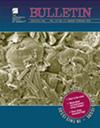Cross-basin chronostratigraphic correlation of carbonate succession (Llandovery, Michigan Basin, USA) using global carbon δ13Ccarb isotope excursions
IF 3.9
1区 地球科学
Q1 GEOSCIENCES, MULTIDISCIPLINARY
引用次数: 0
Abstract
Correlating shallow shelf carbonates and their deep basin equivalents is a perennial challenge in the geosciences, with wide-ranging implications. This hurdle is well illustrated in the Llandovery succession of the Michigan Basin, USA, a 40- to 265-m-thick carbonate interval represented by three lithostratigraphic units: the Cataract, the Burnt Bluff, and the Manistique groups. Although extensively studied at various localities within the basin and across the region, the chronostratigraphic relationships between these units remain unknown. The current study presents a cross-basin chronostratigraphic framework for the Llandovery succession utilizing globally documented carbon (δ13Ccarb) isotope excursions (CIEs). From 10 drill cores and three quarry sites throughout the Michigan Basin, five CIEs were identified and chronostratigraphically constrained using conodont biostratigraphy and conodont 87Sr/86Sr data. The five excursions are interpreted to be the global CIEs: the (1) Hirnantian Isotope Carbon Excursion (HICE; Hirnantian Stage), (2) Early Aeronian, (3) Late Aeronian (Aeronian Stage), (4) Valgu (Telychian Stage), and (5) Ireviken (Sheinwoodian Stage). Most importantly, the HICE and the Ireviken CIEs bracket the Llandovery strata preserved in the basin. The new high-resolution δ13Ccarb data suggest that CIEs can be effectively used to correlate among shallow marine shelf carbonates and their deeper water equivalents. The new chronostratigraphic framework shows that CIE-based time horizons across the Michigan Basin cut across lithostratigraphic unit boundaries, which indicates that these lithostratigraphic units are diachronous in the Michigan Basin. In addition to refining the stratigraphy of the Llandovery succession of the Michigan Basin, particularly the timing of various key sedimentary deposits, the new chronostratigraphic framework can be used to: (1) constrain the timing of various regional tectonic phenomena, (2) identify multiple tectonically driven siliciclastic sediment pulses in the basin, and (3) predict various stratal relationships that may result in previously unknown stratigraphic traps and, therefore, new hydrocarbon plays within the basin. The results of the current study also show that δ13Ccarb trends across the shelf-to-basin transect are spatially and temporally variable and do not match those reported in Modern carbonate settings, which possibly suggests that such δ13Ccarb trends, to some extent, reflect variations in water circulation and water mass heterogeneity during deposition.基于全球碳δ13Ccarb同位素漂移的美国密西根盆地llanddovery碳酸盐岩演替的跨盆地年代地层对比
将浅陆架碳酸盐岩与深盆地碳酸盐岩相比较是地球科学中一个长期存在的挑战,具有广泛的影响。这一障碍在美国密歇根盆地的llanddovery演替中得到了很好的说明,这是一个40至265米厚的碳酸盐层段,由三个岩石地层单元代表:Cataract、burn Bluff和Manistique组。虽然在盆地和整个地区的不同地点进行了广泛的研究,但这些单元之间的年代地层关系仍然未知。本研究利用全球记录的碳(δ13Ccarb)同位素漂移(CIEs),提出了一个跨盆地的llanddovery演替年代地层格架。从密歇根盆地的10个岩心和3个采石场中,利用牙形石生物地层学和牙形石87Sr/86Sr数据确定了5个CIEs,并对其进行了年代地层限制。这5次偏移被解释为全球性的碳同位素偏移:(1)Hirnantian同位素碳偏移(HICE);(2)早Aeronian期,(3)晚Aeronian期(Aeronian期),(4)Valgu (Telychian期),(5)Ireviken (Sheinwoodian期)。最重要的是,HICE和Ireviken CIEs保护了盆地中保存的landovery地层。新的高分辨率δ13Ccarb数据表明,CIEs可以有效地用于浅海陆架碳酸盐及其深水当量之间的关联。新的年代地层格架表明,基于ci的密歇根盆地时间界跨越了岩石地层单元边界,表明这些岩石地层单元在密歇根盆地是穿时的。新的年代地层格架除了可以完善密歇根盆地的llanddovery演替地层,特别是各种主要沉积矿床的年代外,还可以用于:(1)限定各种区域构造现象的时间;(2)识别盆地中多个构造驱动的硅屑沉积脉冲;(3)预测各种地层关系,这些关系可能导致以前未知的地层圈闭,从而在盆地内发现新的油气油气藏。研究结果还表明,陆架-盆地样带的δ13Ccarb趋势具有时空变化特征,与现代碳酸盐岩背景下的δ13Ccarb趋势不一致,这可能在一定程度上反映了沉积过程中水循环和水体非均质性的变化。
本文章由计算机程序翻译,如有差异,请以英文原文为准。
求助全文
约1分钟内获得全文
求助全文
来源期刊

Geological Society of America Bulletin
地学-地球科学综合
CiteScore
9.30
自引率
8.20%
发文量
159
审稿时长
4-8 weeks
期刊介绍:
The GSA Bulletin is the Society''s premier scholarly journal, published continuously since 1890. Its first editor was William John (WJ) McGee, who was responsible for establishing much of its original style and format. Fully refereed, each bimonthly issue includes 16-20 papers focusing on the most definitive, timely, and classic-style research in all earth-science disciplines. The Bulletin welcomes most contributions that are data-rich, mature studies of broad interest (i.e., of interest to more than one sub-discipline of earth science) and of lasting, archival quality. These include (but are not limited to) studies related to tectonics, structural geology, geochemistry, geophysics, hydrogeology, marine geology, paleoclimatology, planetary geology, quaternary geology/geomorphology, sedimentary geology, stratigraphy, and volcanology. The journal is committed to further developing both the scope of its content and its international profile so that it publishes the most current earth science research that will be of wide interest to geoscientists.
 求助内容:
求助内容: 应助结果提醒方式:
应助结果提醒方式:


